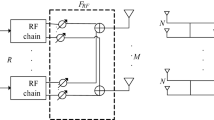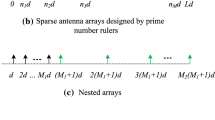Abstract
Non-Orthogonal Multiple Access (NOMA) is one of the blooming technologies in 5G and beyond wireless networks to support a massive number of users with a huge data rate. In this work, we investigate a multiuser hybrid beamforming millimeter wave (mmWave) downlink NOMA system. Wideband mmWave line of sight (LOS) channel and non-line of sight (NLOS) channels are considered in this study. The first step of the multiuser power allocation problem is user clustering, where users are clustered based on their channel correlation and difference. Subsequently, low complex analog beamforming design and zero forcing digital beamforming design are employed. Finally, we formulate users’ power allocation problem with the objectives of spectral efficiency maximization / energy efficiency maximization based on the constraints of users’ quality of service requirements (QoS) and total available power. Existing research solves the non-convex problem by assuming equal power to all the clusters. Then the problem is decomposed into sub-problems and independently solved for each cluster, which increases the complexity. But, we propose a particle swarm optimization (PSO) based single step low complex algorithm, which achieves a faster convergence rate and grants consistent results. Moreover, the simulation results show that our proposed approach outperforms existing sub-optimal method and the conventional zero forcing time division multiple access scheme (ZF-TDMA).








Similar content being viewed by others
Availability of data and materials
Data sharing is not applicable to this article as no datasets were generated or analysed during the current study.
References
Liu, Y., Zhang, S., Mu, X., Ding, Z., Schober, R., Al-Dhahir, N., Hossain, E., & Shen, X. (2022). Evolution of NOMA toward next generation multiple access (NGMA) for 6G. IEEE Journal on Selected Areas in Communications, 40(4), 1037–1071. https://doi.org/10.1109/JSAC.2022.3145234
Benjebbour,A., & Kishiyama,Y., (2018). Combination of NOMA and MIMO: Concept and experimental trials. In 2018 25th International Conference on Telecommunications (ICT), pp. 433–438 https://doi.org/10.1109/ICT.2018.8464916.
Ding, Z., Lei, X., Karagiannidis, G. K., Schober, R., Yuan, J., & Bhargava, V. K. (2017). A survey on non-orthogonal multiple access for 5G networks: Research challenges and future trends. IEEE Journal on Selected Areas in Communications, 35(10), 2181–2195. https://doi.org/10.1109/JSAC.2017.2725519
Islam, S. M. R., Avazov, N., Dobre, O. A., & Kwak, K.-S. (2017). Power-domain non-orthogonal multiple access (NOMA) in 5G systems: Potentials and challenges. IEEE Communications Surveys Tutorials, 19(2), 721–742. https://doi.org/10.1109/COMST.2016.2621116
Maraqa, O., Rajasekaran, A. S., Al-Ahmadi, S., Yanikomeroglu, H., & Sait, S. M. (2020). A survey of rate-optimal power domain NOMA with enabling technologies of future wireless networks. IEEE Communications Surveys & Tutorials, 22(4), 2192–2235. https://doi.org/10.1109/COMST.2020.3013514
Rappaport, T. S., et al. (2013). Millimeter wave mobile communications for 5G cellular: It will work! IEEE Access, 1, 335–349. https://doi.org/10.1109/ACCESS.2013.2260813
Xiao, M., et al. (2017). Millimeter wave communications for future mobile networks. IEEE Journal on Selected Areas in Communications, 35(9), 1909–1935. https://doi.org/10.1109/JSAC.2017.2719924
Hong, W., et al. (2021). The role of millimeter-wave technologies in 5G/6G wireless communications. IEEE Journal of Microwaves, 1(1), 101–122. https://doi.org/10.1109/JMW.2020.3035541
Zhang, D., Zhou, Z., Xu, C., Zhang, Y., Rodriguez, J., & Sato, T. (2017). Capacity analysis of NOMA with mmwave massive MIMO systems. IEEE Journal on Selected Areas in Communications, 35(7), 1606–1618. https://doi.org/10.1109/JSAC.2017.2699059
Budhiraja, I., et al. (2021). A systematic review on NOMA variants for 5G and beyond. IEEE Access, 9, 85573–85644. https://doi.org/10.1109/ACCESS.2021.3081601
Hanif, M. F., Ding, Z., Ratnarajah, T., & Karagiannidis, G. K. (2016). A minorization-maximization method for optimizing sum rate in the downlink of non-orthogonal multiple access systems. IEEE Transactions on Signal Processing, 64(1), 76–88. https://doi.org/10.1109/TSP.2015.2480042
Zhu, F., Lu, Z., Zhu, J., Wang, J., & Huang, Y. (2018). Beamforming design for downlink non-orthogonal multiple access systems. IEEE Access, 6, 10956–10965. https://doi.org/10.1109/ACCESS.2018.2797209
Alavi, F., Cumanan, K., Ding, Z., & Burr, A. G. (2018). Beamforming techniques for nonorthogonal multiple access in 5G cellular networks. IEEE Transactions on Vehicular Technology, 67(10), 9474–9487. https://doi.org/10.1109/TVT.2018.2856375
Xiao, Z., Zhu, L., Choi, J., Xia, P., & Xia, X.-G. (2018). Joint power allocation and beamforming for non-orthogonal multiple access (NOMA) in 5G millimeter wave communications. IEEE Transactions on Wireless Communications, 17(5), 2961–2974. https://doi.org/10.1109/TWC.2018.2804953
Sumathi, S., & Thakre, A. (2019). Impact of Imperfect Channel State Information on Downlink Sum-Rate of Two user mmWave Non Orthogonal Multiple Access. In: 2019 International Conference on Communication and Electronics Systems (ICCES), pp. 1–6. https://doi.org/10.1109/ICCES45898.2019.9002561.
Sumathi, S., Ramesh, T.K., & Ding, Z. (2021). Analog beamforming mm-wave two user non-orthogonal multiple access. Lecture notes of the institute for computer sciences, social informatics and telecommunications engineering, vol. 383. Springer, Cham.
Sumathi, S., Ramesh, T. K., & Ding, Z. (2023). Low complex analog beamforming design in multi-user mmWave non-orthogonal multiple access (NOMA). Journal of Circuits, Systems and Computers. https://doi.org/10.1142/S0218126623502195
Kimy, B., et al. (2013). Non-orthogonal multiple access in a downlink multiuser beamforming system. In: MILCOM 2013 - 2013 IEEE military communications conference, pp. 1278–1283 https://doi.org/10.1109/MILCOM.2013.218.
Cui, J., Ding, Z., & Fan, P. (2017). Beamforming design for MISO non-orthogonal multiple access systems. IET Communications, 11(5), 720–725. https://doi.org/10.1049/iet-com.2015.0746
Ali, S., Hossain, E., & Kim, D. I. (2017). Non-orthogonal multiple access (NOMA) for downlink multiuser mimo systems: user clustering, beamforming, and power allocation. IEEE Access, 5, 565–577. https://doi.org/10.1109/ACCESS.2016.2646183
Ding, Z., Fan, P., & Poor, H. V. (2017). Random beamforming in millimeter-wave NOMA networks. IEEE Access, 5, 7667–7681. https://doi.org/10.1109/ACCESS.2017.2673248
Cui, J., Liu, Y., Ding, Z., Fan, P., & Nallanathan, A. (2018). Optimal user scheduling and power allocation for millimeter wave NOMA systems. IEEE Transactions on Wireless Communications, 17(3), 1502–1517. https://doi.org/10.1109/TWC.2017.2779504
Nasser, A., Muta, O., Gacanin, H., & Elsabrouty, M. (2021). Joint user pairing and power allocation with compressive sensing in NOMA systems. IEEE Wireless Communications Letters, 10(1), 151–155. https://doi.org/10.1109/LWC.2020.3023619
Hao, W., Zeng, M., Chu, Z., & Yang, S. (2017). Energy-efficient power allocation in millimeter wave massive MIMO with non-orthogonal multiple access. IEEE Wireless Communications Letters, 6(6), 782–785. https://doi.org/10.1109/LWC.2017.2741493
Yu, X., Xu, F., Yu, K., & Dang, X. (2019). Power allocation for energy efficiency optimization in multi-user mmWave-NOMA system with hybrid precoding. IEEE Access, 7, 109083–109093. https://doi.org/10.1109/ACCESS.2019.2933328
Zhu, L., Zhang, J., Xiao, Z., Cao, X., Wu, D. O., & Xia, X.-G. (2019). Millimeter-wave NOMA with user grouping, power allocation and hybrid beamforming. IEEE Transactions on Wireless Communications, 18(11), 5065–5079. https://doi.org/10.1109/TWC.2019.2932070
Jiang, J., Lei, M., & Hou, H. (2019). Downlink multiuser hybrid beamforming for Mmwave massive MIMO-NOMA system with imperfect CSI. International Journal of Antennas and Propagation, 2019, 9764958. https://doi.org/10.1155/2019/9764958
Ding, Z., Dai, L., Schober, R., & Vincent Poor, H. (2017). NOMA meets finite resolution analog beamforming in massive MIMO and millimeter-wave networks. IEEE Communications Letters, 21(8), 1879–1882. https://doi.org/10.1109/LCOMM.2017.2700846
Kennedy, J., & Eberhart, R. (1995). Particle swarm optimization. In: proceedings of ICNN’95 - international conference on neural networks, vol. 4, pp. 1942–1948 . https://doi.org/10.1109/ICNN.1995.488968.
Yudong Zhang, Y., Wang, S., & Ji, G. (2015). Comprehensive survey on particle swarm optimization algorithm and its applications. Mathematical Problems in Engineering. https://doi.org/10.1155/2015/931256
Piotrowski, A. P., Napiorkowski, J. J., & Piotrowska, A. E. (2020). Population size in particle swarm optimization. Swarm and Evolutionary Computation. https://doi.org/10.1016/j.swevo.2020.100718
Xu, F., Yu, X., Li, M., & Wen, B. (2019). Energy-efficient power allocation scheme for hybrid precoding mmWave-NOMA system with multi-user pairing. In: 2019 IEEE international conference on communications workshops (ICC Workshops), pp. 1–5 https://doi.org/10.1109/ICCW.2019.8756772.
Funding
The authors did not receive fund from any organization for the submitted work.
Author information
Authors and Affiliations
Contributions
All authors contributed to the study conception and design. Material preparation, investigation and coding were performed by [SS]. Project administration and supervision were done by [TKR] and [ZD]. The first draft of the manuscript was written by [SS] and reviewing and editing was done by [TKR] and [ZD]. All authors read and approved the final manuscript.
Corresponding author
Ethics declarations
Conflict of interest
The authors declare that they have no known competing financial interests or personal relationships that could have appeared to influence the work reported in this paper.
Ethics approval
The authors declare that this manuscript is original and has not been published before and is not currently being considered for publication elsewhere.
Informed consent
The authors declare that this research does not involve human participants and/or animals.
Additional information
Publisher's Note
Springer Nature remains neutral with regard to jurisdictional claims in published maps and institutional affiliations.
Rights and permissions
Springer Nature or its licensor (e.g. a society or other partner) holds exclusive rights to this article under a publishing agreement with the author(s) or other rightsholder(s); author self-archiving of the accepted manuscript version of this article is solely governed by the terms of such publishing agreement and applicable law.
About this article
Cite this article
Sumathi, S., Ramesh, T.K. & Ding, Z. PSO based power allocation in multiuser hybrid beamforming mmWave NOMA. Wireless Netw 29, 2079–2091 (2023). https://doi.org/10.1007/s11276-023-03264-1
Accepted:
Published:
Issue Date:
DOI: https://doi.org/10.1007/s11276-023-03264-1




